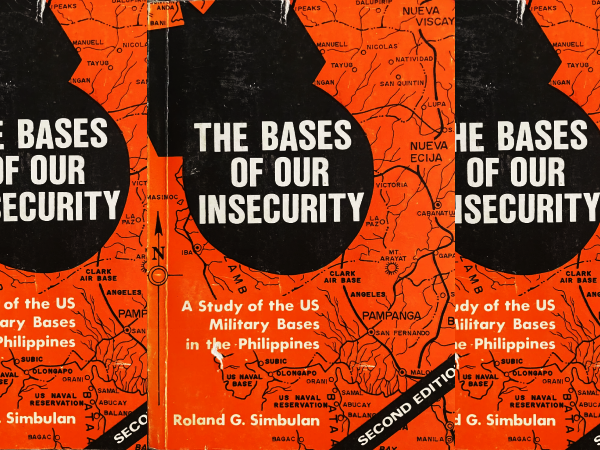A Study of Military Bases in the Philippines by Prof Roland G Simbulan
PROFESSOR Roland G Simbulan’s book, THE BASES OF OUR INSECURITY” is the sort of subject many, if not all the heavies in our friendly military establishments would rather avoid, let alone talk about.
Launched on January 1, 1985, the paperback touches on the very core of heavy-handed American-led approach under the guise of protecting island nations in the Pacific from imagined military attacks by hostile nations.
Interestingly, no one it seemed, had raised a finger since the 335-page paperback was first published by BALAT Fellowship almost four decades ago. So why now?
There are interesting scenarios that the author and others have raised at the launch in Manila, the capital of the Philippines.
Prof Roland Simbulan of the Philippines University cited the Enhanced Defense Cooperation Agreement (EDCA), which the Philippine and the US Governments signed on April 28, 2014.
The agreement is effective for 10 years and thereafter, “unless terminated by either party … giving one year’s written notice.”
The agreement allowed US forces and contractors to operate out of “agreed locations” defined as “facilities and areas that are provided by the Government of the Philippines through the Armed Forces of the Philippines.”
Prof Simbulan argued the agreement “undermines the Philippines’ sovereignty and expose the country to potential attacks from America’s geopolitical rivals,” according to a report carried by the Filipino media company ABS-CBN Corporation.
Simbulan’s latest edition of his book, The Bases of Our Insecurity, delves into the ramifications of foreign military bases in the Philippines.
“… these bases turn the Philippines into a forward base for the US, specifically targeting China. The new EDCA bases, mostly located across (from) Taiwan, would draw the Philippines into the orbit of US-China tensions.”
According to published report prominent figures like coalition activist and WomanHealth NGO advocate Princess Nemenzo and Berlin-based co-president of the Nobel Peace Prize-winning International Peace Bureau Corazon Valdez-Fabros echoed Simbulan’s concerns at the book launch.
Both called on the Philippines government to reassess its alignment with foreign military powers, arguing that historical experiences show such alliances increase the likelihood of the Philippines being dragged into conflicts.
In the latest edition of the book, Simbulan expanded on his critical analysis of the strategic implications of foreign military bases in the Philippines, specifically addressing the controversial nine EDCA bases in the Philippines, of which most of the new ones were located across (from) Taiwan, which China considers a renegade province and not near the West Philippine Sea.
Prof Simbulan described the Philippines as becoming “an aircraft carrier of the US” due to the expanded American military presence here with EDCA bases and the Visiting Forces Agreement, which he said are clearly targeting US’s strategic rival China and their cities.
“… foreign military bases in the Philippines posed significant risks, including entanglement in increasing conflicts among superpowers such as the US, China and Russia.
”… the EDCA bases would compromise the Philippines’ national sovereignty and make them a target for attacks in geopolitical rivalries,” Prof Simbulan said.
Simbulan also cited Russian President Putin’s recent public complaint and warning that the presence of mid-range US missiles in the Philippines would elicit a response and that this would pose a grave danger to the nation’s safety.
He also recounted that a Vietnamese official speaking at the University of the Philippines said during the Vietnam War, the US had used their military bases in the Philippines to keep bombing Vietnam and other countries of Indo-China, and that if the Vietcongs then had military capabilities then, they would have struck back at Philippine targets.
Nemenzo highlighted the historical and sociopolitical context of foreign military presence in the Philippines. She asserted that Philippine experiences with foreign bases have repeatedly shown that they do not contribute to their security but rather increase the likelihood of their involvement in conflicts not of their making.
“… it is time for the Philippines to pursue a truly independent foreign policy, free from entanglements with any big powers, adding that the Philippines should oppose war and foreign military bases.
“… the presence of foreign military bases undermines Philippines’ efforts to uphold peace, national sovereignty and stability. … the Philippines should focus on building self-reliant national defence capabilities rather than aligning with any major power bloc to avoid getting into wars, asserting that the Philippines must avoid becoming a pawn in potential proxy wars by the superpowers,” Valdez-Fabros said.
What are the implications for Solomon Islands and the Pacific as a whole hosting US military bases? Does US military bases provide security or insecurity for us?
There are dire consequences for Solomon Islands as was experienced during and after the Second World War. Like the Solomon Islands, the Philippines has realized that the United States never accept responsibility for its actions.
Solomon Islands has found itself being a minefield of unexploded ordnances remain today. Many unsuspecting young men and women have either been killed or maimed in explosions.
Island provinces such as Guadalcanal, the Russell Islands and Western are littered with unexploded bombs of various kinds. US authorities, it seems, are more comfortable with a band-aid approach in terms of cleaning up their mess than a full sweep of these islands.
The Philippines is located about 3, 145 miles or about 5, 061.39km by air from Solomon Islands. The US, which has all but forgotten about Solomon Islands for some 80 years, began interfering in the diplomatic relations that Beijing and Honiara established in September of 2019.
An outbreak of hostility will definitely affect Solomon Islands in more ways than one.
The Pacific Ocean is defined by the Oxford Dictionary as “Peaceful in character and intent.”
Since its discovery It is said to be the “largest and deepest ocean basin on Earth, covering more than 155 million square kilometers (60 million square miles) and averaging a depth of 4,000 meters (13,000 feet).
In 1520, Explorer Ferdinand Magellan called this body of water “pacific,” due to the calmness of the water at the time (‘pacific’ means peaceful). Does the US have the right to ‘dirty’ our pristine waters of the Pacific?
Why is the US so keen about destroying our own environment for this and future generations?
Drawing from various published reports, it would seem peace is absent from the dictionary of the world’s largest democracy. Money and power are at the root of America’s militarism.
A report published on 29 January 2024, shows US weapons sales overseas rose sharply last year, reaching a record total of $238bn (£187bn), as Russia’s invasion of Ukraine stoked demand.
“In the establishment of the US bases (in the Philippines), particularly of Fort Stotsenberg, Clark Airfield, Subic Bay, and John Hay, frequently resulted in the displacement and disenfranchisement of the Aeta and Ibaloi indigenous peoples who lived in the land, at a time when they were already facing pressures from the incursions of civilian lowlanders.
“None of these indigenous peoples were properly compensated at the time the bases were established, and they remain marginalized and unable to return to their historic lands today.”
There was leftover of toxic wastes in Subic and Clark Air Base as soon as the US turned over the bases over to the Philippine Government,
“At the time, the U.S. government and United Nations reports confirmed “serious contamination at 46 locations in the two bases had come out. But the U.S. government determined that it was not legally responsible for the cleanup,” reports from the Philippine said.
By Peter Maesi
Vara Creek, Honiara




